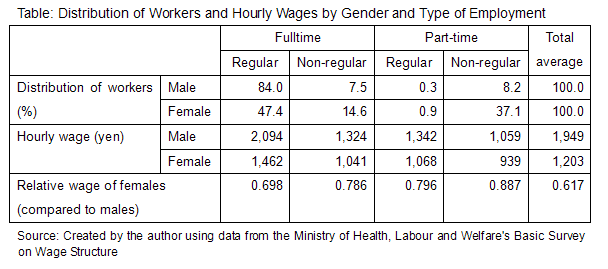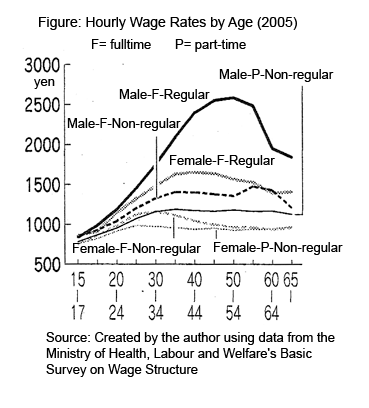Why has Japan been unable to narrow the wage gap between men and women? Is there any economic rational in the presence of these gaps? This article seeks to examine these questions. A joint study by Daiji Kawaguchi, associate professor at Hitotsubashi University and Hirokatsu Asano, associate professor at Asia University, showed that the productivity of female workers relative to male workers at the same workplace is proportional to their relative wages. It is wrong, however, to interpret this finding as justifying women's lower wages because their productivity is lower. Instead, this should be seen as evidence for the economic irrationality of underutilizing the female workforce in Japanese companies. Matching the wage rate level to the productivity level is economically rational, but Japan typically exhibits what can be described as "reverse matching," wherein lower wages for women result in lower productivity from women.
Female workforce is underutilized
According to Casey B. Mulligan, professor at the University of Chicago, the aggregate earnings of U.S. women was about one-third those of men in the mid-1970's, but have since increased to about two thirds. This marks a twofold increase for women, where as the aggregate earnings for men barely changed in the same period. It follows that the growth in the U.S. aggregate earnings during that 30-year period can be fully attributed to growth in women's earnings. This remarkable increase in the aggregate earnings of U.S. women has been brought about primarily by the increased employment rate of married women and the narrowing gender gap in the hourly wage.
Meanwhile, Japan has been relatively slow in utilizing its female workforce. A look at hourly wages by gender and employment shows that the gap between men and women is largest among fulltime regular employees, with a 70-to-100 ratio of female-to-male wages, compared to 89-to-100 among part-time non-regular employees (Table). The average ratio lowers to 62-to-100, resulting in a wider gap, due to the high concentration of women in low-wage employment types. That is, when measured in terms of quality, only about 60% of the ideal female work capacity is now being utilized in Japan.
A look at hourly wage rates for men and women by age group and type of employment (Figure), shows that the male-female gap in age-based premiums significantly expands as age increases for fulltime regular workers.
Factors behind the wage gap
A decomposition analysis of the overall male-female wage gap shows that: 1) 31.3% of the gap is attributable to differences in the employment type between men and women; 2) 55.1% to the male-female wage gap among fulltime regular employees; 3) 4.4% to the gap among fulltime non-regular employees; 4) 0.2% to the gap among part-time regular employees; 5.0% to the gap among part-time non-regular employees, and 4.0% to differences in the age distribution of male and female employees. Factors 1 and 2 thus account for more than 80% of the overall male-female gap.
Of the gap among fulltime regular workers, the largest factor noted above, the portion attributable to gender difference in the number of years worked, accounts for only about 13%, with the remaining 87% attributable to gender differences in promotion opportunities and in the growth rate of tenure-based salary premiums
One major institutional factor behind the gap among regular workers is discriminatory treatment of women resulting from the career track system (kosu sei) under which employees are typically classified into two categories: those who are on a administrative/management track (sogo shoku), and eligible for promotions, and those who are confined to routine clerical tasks (ippan shoku) for which the majority of the women are recruited. It appears to me that what lies beneath this is statistical discrimination; the practice of uniformly applying group averages as a basis for personnel decisions due to the indeterminacy of individual qualities and characteristics. Theoretical rationale for this practice was first pointed out by Edmund Phelps, professor at Columbia University. More specifically, the attrition rate of women for reasons related to marriage and/or childrearing is high (about 70%), and companies, considering this a cost, tend to apply a uniformly low wage scale--determined by incorporating the average cost of turnover--to the majority of female employees.
This application of statistical-discrimination theory is irrational, especially in the context of Japan, however. I discuss this in more detail in Debates; Work-life Balance in Japan, but in short, I consider that companies, especially those in Japan, incur enormous opportunity costs by underutilizing women as competent human resources. For instance, statistical discrimination generates a self-fulfilling prophesy in that women choose to quit because companies discriminate against them in anticipation of the leaving for childrearing. In addition, statistical discrimination results in adverse selection wherein women with relatively high productivity, who deserve higher wages, are more likely to leave.
Furthermore, by applying a theoretical model developed by Stephen Coate, professor at Cornell University, and Glenn Loury, professor at Brown University, we can consider discriminatory treatment of female workers on the routine clerical track under the career track system as decreasing their incentive to invest in their own human capital, thereby lowering their productivity and thereby generating the reverse matching situation described above. Coate and Loury argue that firms' positive action policies to preferentially increase the opportunities for women are effective under certain conditions in solving this problem.
However, the biggest problem is the mindset of companies that focus solely on the costs of turnover for women in order to keep tenure-based premiums at a minimum and limit promotion opportunities for women, but never seek to reduce the rate of attrition of female employees. The attrition rate of women in the workforce actually increases because of the discrimination against women.
In the United States and Europe, companies are taking measures to promote diversity in the workplace and help employees achieve a better work-life balance. These efforts have been undertaken mainly for the purpose of retaining competent female and minority workers. Most women do not want to sacrifice either their work or family life. Under an employment system that forces women to sacrifice their family life, companies cannot effectively utilize women's abilities. Respecting the diverse preferences of individual employees regarding the way they work, instead of forcing them to work in a specific way, is the key to effective utilization of employees who seek balance in their work and family lives, and this includes men. Work-life balance policies by companies are intended to achieve this end.
Three institutional factors yield the male-female wage gap attributable to differences in the employment type, the second biggest factor behind the male-female wage gap. First, in Japan, opportunities to obtain regular employment are institutionally distributed against women's life preferences: most of these opportunities are available exclusively to first-time job seekers fresh out of school, and therefore women, once they have quit their first job in order to raise children, are left with little chance of finding a job with regular employment when they return to the workforce. Second, because part-time regular employment is not prevalent in Japan, choosing part-time work must lead, in most cases, to the involuntary choice of non-regular employment status. Third, pay equity in the hourly wage between fulltime and part-time employees has not yet been achieved in Japan.
Results of my simulation analyses show that the male-female wage gap due to gender difference in the employment type will not be eliminated unless all three institutional barriers are eliminated simultaneously. For instance, ensuring pay equity in the hourly wage between fulltime regular employees and their part-time counterparts is almost meaningless unless part-time regular employment becomes prevalent.
Effectively utilizing the female workforce
In order to effectively utilize the female workforce it is important to: 1) abolish the career track system that deprives those on the clerical track of incentives for enhancing their own productivity; 2) establish a system that allows individual employees to choose between fulltime and part-time positions suitable to their own circumstances, with consideration given to the tendency for female workers to prefer part-time work arrangements while rearing children; 3) ensure equal treatment between fulltime and part-time workers by using hourly productivity, not daily, as a performance measurement; 4) pave the way for reemployment of competent workers to regular employment status by establishing a maternity and childrearing system with guaranteed reinstatement rights; and 5) promote implementation of management policies that encourage positive actions for workplace equity.
Flexibility in the workplace should be promoted, not as another welfare facility but from the viewpoint of utilizing human resources with diverse life plans. This does not contradict Japan's conventional employment practices that are predicated on long-term employment. The conventional employment system is irrational in that it is so one-sidedly geared to the utilization of employees predicated on long-term employment and securing reasonable returns on firms' human resource investments that those who do not fit into these mainstream criteria are not given any incentive to improve their productivity. This is the case for the utilization of non-regular workers as a whole, both female and male, as well as of female regular employees in the routine clerical track
Equally important is emotional/moral support in the workplace environment that consoles and/or encourages women struggling to balance work and family. The stress brought on by trying to manage workplace duties and domestic responsibilities such as childrearing can become bigger or smaller depending on the workplace environment. Excessive stress negatively affects productivity.
Employee evaluation in terms of hourly productivity is generally on a merit-based system. However, when employees are evaluated based solely on individual performance, they are tempted to keep their knowhow and expertise to themselves, preventing information-sharing and cooperation among colleagues. To reduce such disincentives for cooperation, employees should be evaluated not only on individual work performance but also on their role in helping their colleagues and subordinates improve their productivity. Giving emotional/moral support, as mentioned above, is one form of re-energizing their colleagues. In the U.S., many companies list the promotion of diversity and work-life balance as a criterion for evaluating the performance of mid-level managers. Institutional reform is important, but fostering and ensuring mid-level managers who, by caring for their staff's family circumstances, can build the motivation of those they work with, is also important
* Translated by RIETI.
June 16, 2008 Nihon Keizai Shimbun




